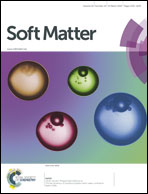Probing evaporation induced assembly across a drying colloidal droplet using in situ small-angle X-ray scattering at the synchrotron source†
Abstract
Colloidal particles in a tiny drying droplet are forced to assemble due to attractive capillary forces. Jamming of the particles throughout the droplet remains either isotropic or anisotropic depending upon the drying kinetics and the physicochemical environment. In this work, we explore the dynamical evolution of such an assembly process across a single evaporative droplet by in situ scanning small-angle scattering using a micro-focused X-ray beam at the synchrotron source. A methodology has been elucidated to differentiate quantitatively between the isotropic and the anisotropic jamming process. Switching of jamming behaviour depending on the initial particle volume fraction in the droplet has been demonstrated. Three distinct stages of assembly, associated with droplet shrinkage, have been revealed even during isotropic jamming. This is in contrast to the drying of a pure liquid droplet under diffusion limited evaporation. It has been established that such in situ scattering measurements can also be used to estimate the temporal evolutions of the viscosity of a drying suspension as well as the diffusivity of nanoparticles in a droplet.


 Please wait while we load your content...
Please wait while we load your content...